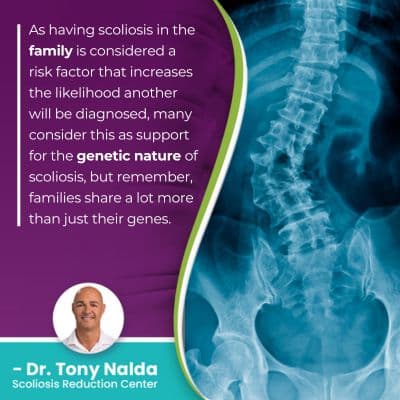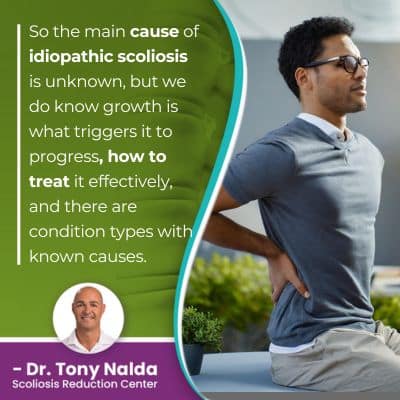What Is the Main Cause of Scoliosis? Learn More Here!

Condition type is determined by causation, and while most cases of scoliosis have no known cause (idiopathic scoliosis), there are condition types with known causes: neuromuscular, degenerative, and congenital. Continue reading to learn more about the etiology of scoliosis.
There are different types of scoliosis a person can develop, and the most common type has no known cause: idiopathic scoliosis. Types of scoliosis associated with known causes are considered atypical, and the cause of the main type of scoliosis is unknown.
Let's start with how scoliosis is diagnosed as there are a number of spinal conditions that cause a loss of healthy spinal curves, but scoliosis is unique in a number of ways.
Table of Contents
How is Scoliosis Diagnosed?
Scoliosis is diagnosed through a combined physical examination that includes taking the patient's family history and medical history, an Adam's forward bend test, and X-ray results to see what's really happening in and around the spine, to confirm a rotational component, and determine the patient's Cobb angle measurement.
Scoliosis involves the development of an unnatural sideways curve of the spine that also twists, making scoliosis a 3-dimensional condition that needs to be addressed as such.
Scoliosis is a progressive condition, so its nature is to get worse over time, and this means the size of the unnatural spinal curve will increase, along with the condition's uneven forces, and their effects.
Scoliosis gets more complex to treat the more it progresses; the spine gets increasingly rigid, and this makes it less responsive to treatment and can make it difficult for some patients to perform key therapeutic exercises as part of treatment.
Part of diagnosing scoliosis involves further classifying conditions based on key variables: patient age, condition severity, curvature location, and type.
Condition severity is determined by a patient's Cobb angle, and the higher a Cobb angle, the more severe the condition, and the more noticeable its effects are likely to be:
- Mild scoliosis is diagnosed with Cobb angle measurements of between 10 and 25 degrees
- Moderate scoliosis is diagnosed with Cobb angle measurements of between 25 and 40 degrees
- Severe scoliosis is diagnosed with Cobb angle measurements of 40+ degrees
- Very severe scoliosis is diagnosed with Cobb angle measurements of 80+ degrees
Condition severity is a key variable that treatment plans are shaped around, and when it comes to the type of scoliosis, this is determined by causation.
Different Types and Causes of Scoliosis
There are 4 main types of scoliosis.
The most common type of scoliosis to affect all ages is idiopathic scoliosis, and idiopathic means not clearly associated with a single-known cause.
Idiopathic isn't the same as saying a complete absence of a cause and is instead thought to have multiple causes: multifactorial.
Is idiopathic scoliosis genetic?
 Considering how prevalent scoliosis is, it's not surprising that a lot of research and studies have been done on whether or not idiopathic scoliosis is genetic.
Considering how prevalent scoliosis is, it's not surprising that a lot of research and studies have been done on whether or not idiopathic scoliosis is genetic.
Particularly as the most common type of scoliosis overall is adolescent idiopathic scoliosis, diagnosed between the ages of 10 and 18 and the fact that idiopathic scoliosis is the leading spinal condition among school-aged children, awareness is important.
Despite the amount of time spent looking for a single gene, or genetic mutation, that accounts for the development of idiopathic scoliosis, it has yet to be identified, and it's generally thought that scoliosis is not genetic, but is familial.
As having scoliosis in the family is considered a risk factor that increases the likelihood another will be diagnosed, many consider this as support for the genetic nature of scoliosis, but remember, families share a lot more than just their genes.
Families share body type, diet, lifestyle, responses to stress, posture, socioeconomic factors, geography, and more, and considering the multifactorial nature of scoliosis, it makes sense that the onset of idiopathic scoliosis could be a combination of these different variables, and that combination can change from patient to patient.
So the main cause of idiopathic scoliosis is unknown, but we do know growth is what triggers it to progress, how to treat it effectively, and there are condition types with known causes.
Scoliosis Types With Known Causes
Idiopathic scoliosis accounts for approximately 80 percent of known cases, and the remaining 20 percent are associated with known causes: neuromuscular scoliosis, degenerative scoliosis, and congenital scoliosis.
Idiopathic scoliosis is considered typical and features right-bending curves, important because the spine bends away from the heart, but in atypical types, curves can bend to the left, towards the heart.
When I see a left-bending curve, I know an underlying pathology is the cause of the scoliosis onset, and treatment plans have to be adjusted accordingly.
Neuromuscular Scoliosis
Neuromuscular scoliosis (NMS) is commonly the most severe, and this is because the scoliosis develops as a secondary complication of a larger neuromuscular condition such as spina bifida, cerebral palsy, or muscular dystrophy.
While having a neuromuscular condition doesn't guarantee a scoliosis diagnosis, it is a common complication; neuromuscular conditions cause a disconnect between the brain, the spine, and the muscles and/or connective tissues that support the spine.
Because of the larger neuromuscular condition, these cases tend to be severe, the curves are more rigid, and tend to progress quickly.
Some patients with NMS become unable to walk on their own and wheelchair-bound.
Degenerative Scoliosis
Idiopathic scoliosis is the most common type to affect adults, and the second most common type is degenerative scoliosis that affects older adults and is more common in females than males; this is due to bone density and hormone changes related to menopause.
Natural age-related spinal degeneration most often starts with the spine's discs as they are key to spinal health and function, and once they start to deteriorate and change shape, they disrupt the spine's ability to maintain its natural curves and alignment.
As scoliosis develops and the spine is degenerating, it becomes increasingly unbalanced and unstable, and this can make the scoliosis progress quickly, even though the trigger of growth is removed in adult scoliosis.
Congenital Scoliosis
 Congenital scoliosis is caused by spinal malformations that develop in utero; this is a rare type affecting approximately 1 in 10,000.
Congenital scoliosis is caused by spinal malformations that develop in utero; this is a rare type affecting approximately 1 in 10,000.
Babies born with congenital scoliosis need to be comprehensively assessed and monitored because they often present with additional congenital abnormalities.
Common spinal malformations that disrupt the spine's ability to develop its healthy and natural curves and alignment include vertebral bodies (bones of the spine) being more triangular than rectangular in shape, which causes the spine to wedge forward.
There are also malformations that involve vertebral bodies failing to separate and forming fused together as one solid bone.
Conclusion
The main cause of the main type of scoliosis (idiopathic) is unknown, but I remind patients that regardless of what causes scoliosis to develop, it's how a diagnosis is responded to that shapes a patient's spinal health, function, and responsiveness to treatment.
Idiopathic scoliosis is considered to be familial, meaning a family history of scoliosis can be explained by the condition's multicultural nature, and familial factors include shared body types, responses to stress, postures, diets, lifestyles, socioeconomic factors, and more.
While we don't know what triggers the initial onset of idiopathic scoliosis, we do know that it's growth spurts that trigger progression, which is why childhood scoliosis progresses faster than adult scoliosis.
It's important for patients to understand that regardless of condition severity or cause, all types are progressive so are virtually guaranteed to get worse over time, particularly if left untreated or not treated proactively.
Here at the Scoliosis Reduction Center, I've treated all types and severity levels of scoliosis, and what I've learned is that the earlier in a condition's progressive line a diagnosis and intervention is reached, the better the patient is likely to respond.
Scoliosis that's mild is simpler to treat, and in general, it's far more effective to proactively work towards a curvature reduction and increasing core strength than it is to attempt to reverse the effects of progression once they've occurred.
In children, the main effect of scoliosis involves postural changes (uneven shoulders, uneven shoulder blades, development of a rib cage arch, uneven hips) and disruptions to balance, coordination, and gait.
In adults, the main scoliosis symptom that gets worse with progression is pain, and that's because scoliosis becomes a compressive condition once skeletal maturity has been reached.
So while the main cause of scoliosis remains unknown, the condition can be highly treatable, particularly when a proactive conservative treatment approach is applied as close to the time of diagnosis as possible.
Dr. Tony Nalda
DOCTOR OF CHIROPRACTIC
After receiving an undergraduate degree in psychology and his Doctorate of Chiropractic from Life University, Dr. Nalda settled in Celebration, Florida and proceeded to build one of Central Florida’s most successful chiropractic clinics.
His experience with patients suffering from scoliosis, and the confusion and frustration they faced, led him to seek a specialty in scoliosis care. In 2006 he completed his Intensive Care Certification from CLEAR Institute, a leading scoliosis educational and certification center.
About Dr. Tony Nalda
 Ready to explore scoliosis treatment? Contact Us Now
Ready to explore scoliosis treatment? Contact Us Now





